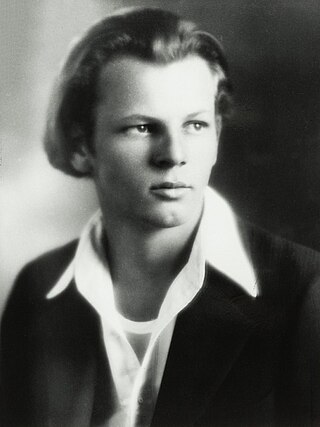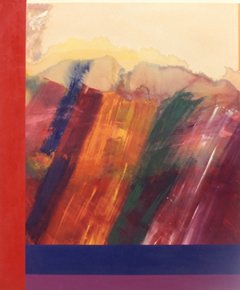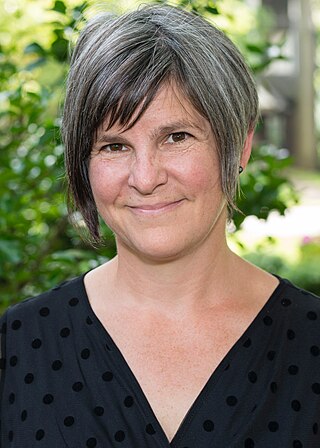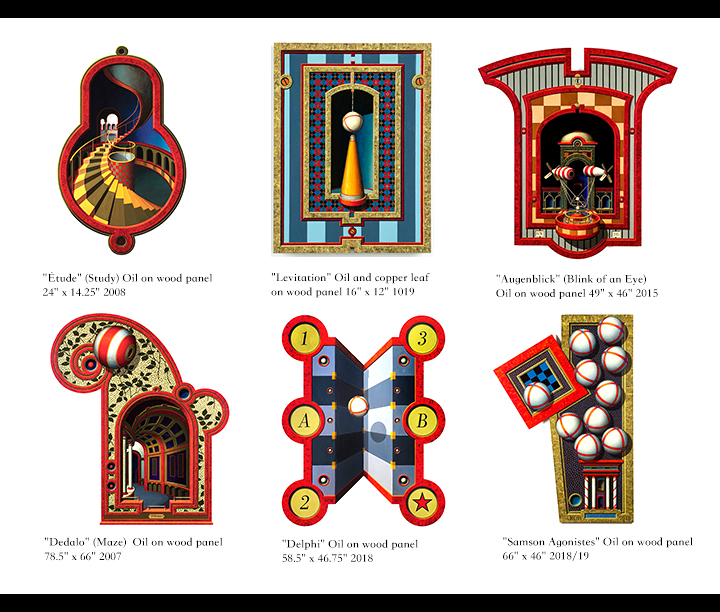
Paul Jackson Pollock was an American painter. A major figure in the abstract expressionist movement, Pollock was widely noticed for his "drip technique" of pouring or splashing liquid household paint onto a horizontal surface, enabling him to view and paint his canvases from all angles. It was called all-over painting and action painting, since he covered the entire canvas and used the force of his whole body to paint, often in a frenetic dancing style. This extreme form of abstraction divided the critics: some praised the immediacy of the creation, while others derided the random effects.

Ronnie Landfield is an American abstract painter. During his early career from the mid-1960s through the 1970s his paintings were associated with Lyrical Abstraction, and he was represented by the David Whitney Gallery and the André Emmerich Gallery.
David Dewey is an American landscape painter, known for his watercolor works. In 1968 he received his BFA from Philadelphia College of Art, and in 1974, his MFA from Washington State University. He is represented by Bernaducci Meisel Gallery, in New York City, NY. His work is very focused on light properties.

Dorothea Rockburne, DFA is an abstract painter, drawing inspiration primarily from her deep interest in mathematics and astronomy. Her work is geometric and abstract, seemingly simple but very precise to reflect the mathematical concepts she strives to concretize. "I wanted very much to see the equations I was studying, so I started making them in my studio," she has said. "I was visually solving equations." Her attraction to Mannerism has also influenced her work.

Duke Riley is an American artist. Riley earned a BFA in painting from the Rhode Island School of Design, and a MFA in Sculpture from the Pratt Institute. He lives in Brooklyn, New York. He is noted for a body of work incorporating the seafarer's craft with nautical history, as well as the host of a series of illegal clambakes on the Brooklyn waterfront for the New York artistic community. Riley told the Village Voice that he has "always been interested in the space where water meets land in the urban landscape."
Charles Seliger was an American abstract expressionist painter. He was born in Manhattan June 3, 1926, and he died on 1 October 2009, in Westchester County, New York. Seliger was one of the original generation of abstract expressionist painters connected with the New York School.

Edward Dugmore was an abstract expressionist painter with close ties to both the San Francisco and New York art worlds in the post-war era following World War II. Since 1950 he had more than two dozen solo exhibitions of his paintings in galleries across the United States. His paintings have been seen in hundreds of group exhibitions over the years.
Thomas Sills was a painter and collagist and a participant in the New York Abstract Expressionist movement. At the peak of his career in the 1960s and 1970s, his work was widely shown in museums. His work was regularly featured in art journals and is in museum collections.
Nancy Grossman is an American artist. Grossman is best known for her wood and leather sculptures of heads.
Lari George Pittman is a Colombian-American contemporary artist and painter. Pittman is an Emeritus Distinguished Professor of Painting and Drawing at the UCLA School of the Arts and Architecture.
Juan Sánchez, also Juan Sanchez is an American artist and educator. He is an important Nuyorican cultural figure to emerge in the second half of the 20th century. His works include photography, paintings and mixed media works.

Polly E. Apfelbaum is an American contemporary visual artist, who is primarily known for her colorful drawings, sculptures, and fabric floor pieces, which she refers to as "fallen paintings". She currently lives and works in New York City, New York.
William E. F. Heeks, Jr., popularly known as Willy Heeks, is an American abstract expressionist painter.
Steve Locke is an American conceptual artist who explores figuration and perceptions of the male figure, and themes of masculinity and homosexuality through drawing, painting, sculpture and installation art. He lives and works in upstate New York and in Brooklyn where he teaches at Pratt Institute.

Harry Kramer is an American abstract painter, born in Philadelphia, Pennsylvania. In 1962 he received a BFA from The University of Arts and earned an MFA from Yale University in 1965.

Beth Lipman is a contemporary artist working in glass. She is best known for her glass still-life compositions which reference the work of 16th- and 17th-century European painters.
Ann Pibal is an American painter who makes geometric compositions using acrylic paint on aluminum panel. The geometric intensity is one of the key characteristics that defines her paintings.
Eve Aschheim is an American draftsperson and painter.
Erik Levine is an American visual artist. He is a Professor of Art in the College of Liberal Arts at the University of Massachusetts Boston.

Creighton Michael is an American abstract artist. He earned his B.F.A. in painting from the University of Tennessee, his M.A. in art history from Vanderbilt University, and later received an M.F.A. in painting and multimedia from Washington University in St. Louis.












